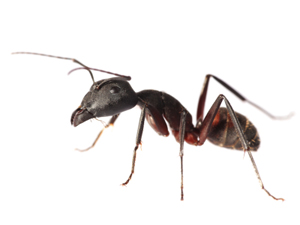Biology and Life Habits:

In their natural surroundings, Carpenter ants are beneficial insects. Excavation of galleries in wood, has earned them their name. They are beneficial since they feed on many pests. They are the largest of our common ants, the brown or black workers measuring from 6 to 13 mm (1/4” to 1/2 “) in length, while the queen may be more than 25mm (1”) long. In late spring and early summer, mature Carpenter ant colonies produce winged adults. These swarm in mating flights, and may be a nuisance around homes at these times.
Outdoors, they nest in any wood that is in close contact to a moisture source, for example, stumps, landscape ties and wooden fence posts. In buildings, they often make their nests in hollow doors, in wood cabinets near dishwashers, in damp locations behind baseboards, fireplaces, window frames, and in basements and attics. Carpenter ants will rarely do extensive damage to wood. They usually limit the size of the colony to the area of the damp wood. Several so called satellite colonies may, however be constructed in the same structure.
Carpenter ants may be seen in infested buildings at any time of the year searching for food at considerable distances from their nest. In some colonies a dormancy period occurs for several weeks during the winter months. Although they chew their way through wood, leaving frass particles resembling sawdust, they do not eat wood. Instead, they feed on a wide range of insects, plant materials and, occasionally, on household foodstuffs.
What are their Breeding Habits?
Carpenter ants are social insects, living in colonies. Within the colony winged reproductives are not produced until the colony is established, which takes about two to three years. After mating the winged reproductives leave the colony to establish new ones. Once established, an average colony contains 2,000 to 3,000 carpenter ants.
Are they hazardous to Humans?
Yes. Since carpenter ants are attracted to foods such as honey, jelly, fruit and meat, they can carry disease germs from one area to another. Although they do not sting, they can inflict bites.
Preparation Guidelines:
In areas where ants are seen and in particular the kitchen, empty bottom cupboards and the bottom of closets. Dishes and food should be kept out of the way. If ants are seen in the washroom, the vanity should be emptied. Sometimes it is necessary for the Reliable Technician to drill into walls and ceiling areas to access a carpenter ant nest. Holes will be sealed at the time of service. If bait stations are used during the time of service, they should be left where the Reliable Technician places them. Please do not disturb. Vacate the premises during service and do not re-enter until at least 4 hours after treatment. Open windows for 20 minutes after re-entry if possible. If you have any questions after the service we would be happy to help, please call. We offer carpenter ants control services in Toronto, Pickering, Whitby, Mississauga and Oakville.
How do weather conditions affect them?
Warm, moist weather presents ideal conditions for carpenter ant colonies to establish themselves
Signs of Infestation:
The presence of worker ants in your home is one of the first indications of an establishing carpenter ant colony. Check all areas where you suspect moisture. The presence of frass (chewed wood similar to sawdust) is an indication of an active nest.
Prevention Techniques:
The elimination of moist conditions by providing good ventilation and isolating wood from any direct contact with the soil will aid in carpenter ant prevention. Foods should be kept in sealed containers and areas where food is stored kept free of spillage or crumbs. Eliminate old lumber, logs and stumps from around your property and do not store firewood inside the building. In the case of new construction only properly treated lumber should be used. Reliable is a prominent carpenter ants Toronto exterminator offering services to the residents.
Are carpenter ants not what you are looking for? Visit the Pest Information section for a broader selection of ants.
